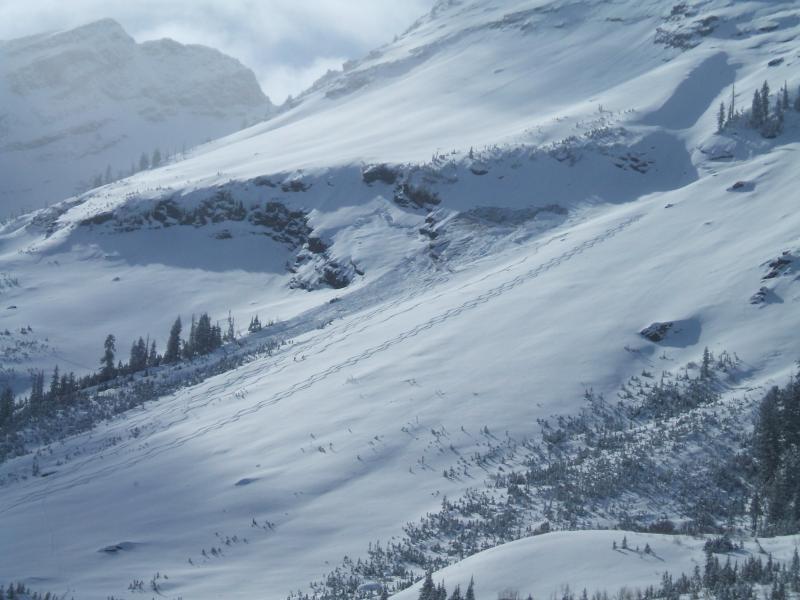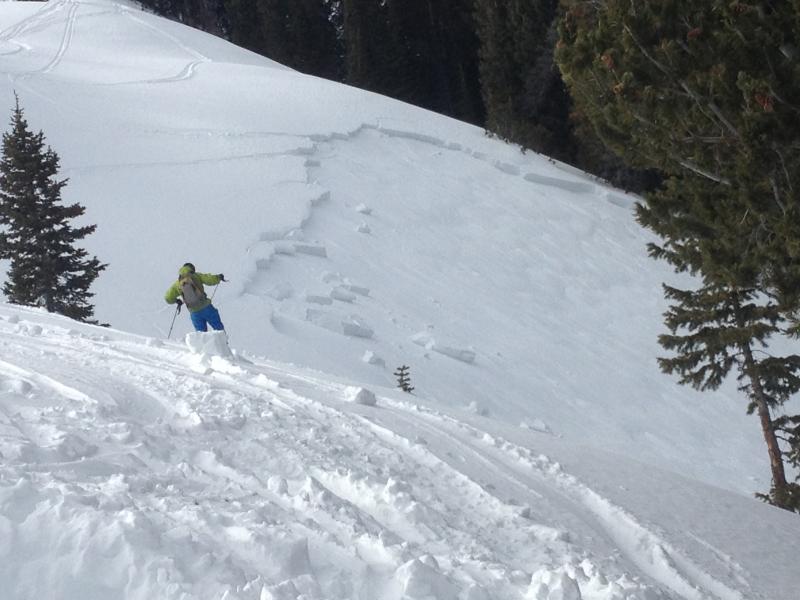
What follows will be a very personal account of the 2012/2013 winter season. Read on and you'll understand.
From my April 10th 2013 avalanche advisory...
While an east wind blows
Friend looks cancer in the eye
Magnolia tree blooms
I often like to say that nothing good comes of an east wind...but sometimes there are good things that are coincident with it. Just ask the old man in the haiku.
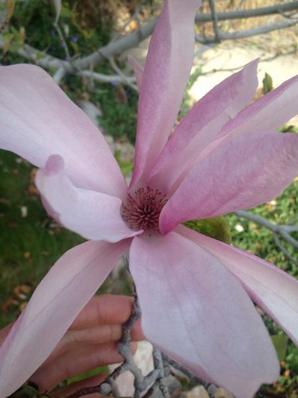
One friend – a mentor – is cleared of cancer the day before…the following day a good friend, a colleague, a husband and father dies in an avalanche. From my advisory just after the accident -
My friend Tim wrote this from Glacier Bay years ago, though re-reading it now reminds me of our lost colleague Craig Patterson. Much of his heart was in Alaska, too.
“We camped on a gravel slope below White Thunder Ridge, and we might have gotten some sleep were it not for the damn Northern Lights, which arced across an ebony starfield like green smoke interspersed with dozens of red lightning bolts running in ultra-slow motion. All the while, the sound of calving ice rumbled off the ridge above. It was like having the whole damn philharmonic orchestra come over to play Beethoven for you at midnight. The mindless and ungrateful go to sleep so they can rise up in the morning fully rested and spiritually impoverished.” We are all in this journey together; we’ve either lost someone or will lose someone down the road. It’s the lesson we share of impermanence and a reminder to be grateful for each day that we have with the ones we love. Lose some more sleep tonight, friends - remember that we live charmed lives; remember that always.
Below...in all, eight avalanche professionals from the Utah Avalanche Center and the Utah Department of Transportation went up to Kessler Peak to conduct the investigation. (photos Bruce Tremper)
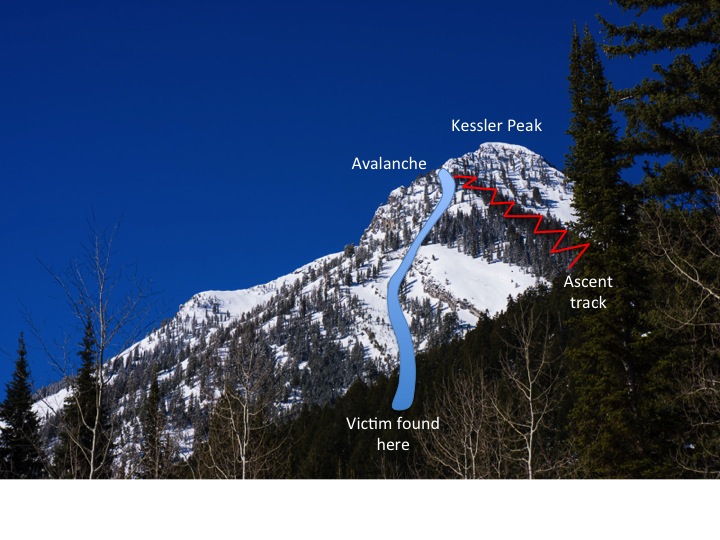
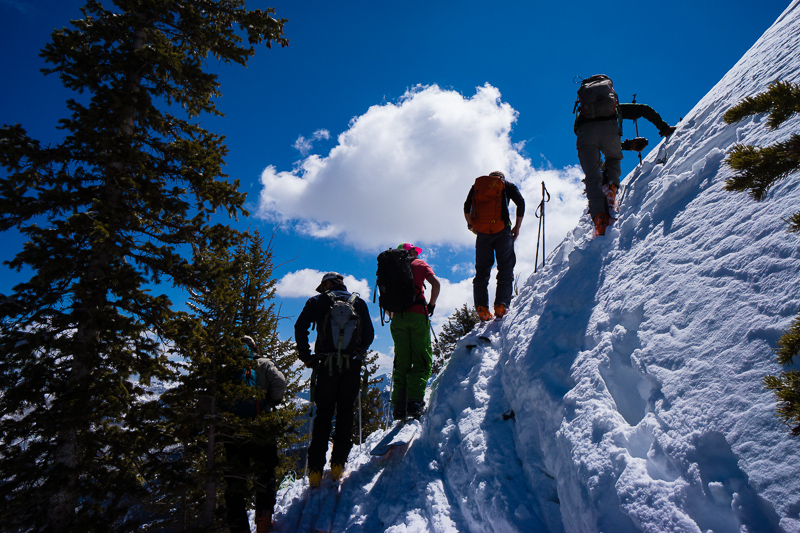
By the numbers:
Avalancheinvolvementsreported to us included 51 caught and 34 carried, 10 partial and 6 full burials, and four out of 24 nationwide fatalities. Colorado alone has suffered nearly half of the national fatalities with 11. By comparison, the west had 34 avalanche fatalities for the 2011-2012 winter. The Alta Guard Station in upper Little Cottonwood Canyon, with annual snow measurement going back to the 1944/45 season, recorded a well-below-average 381.5”/33.13” (snow/water as measured November 1 – April 30) for the year, 76% of average. We didn’t see any overwhelming avalanche cycles or struggle with any widespread or significant weaknesses for the 12/13 season. Our fatalities and a couple of our close calls I've highlighted below. (Our full blown avalanche accident investigations can be found here.)
(Below, a booby-trap amongst the ski tracks - a remotely triggered avalanche late December on Gobbler's Knob)
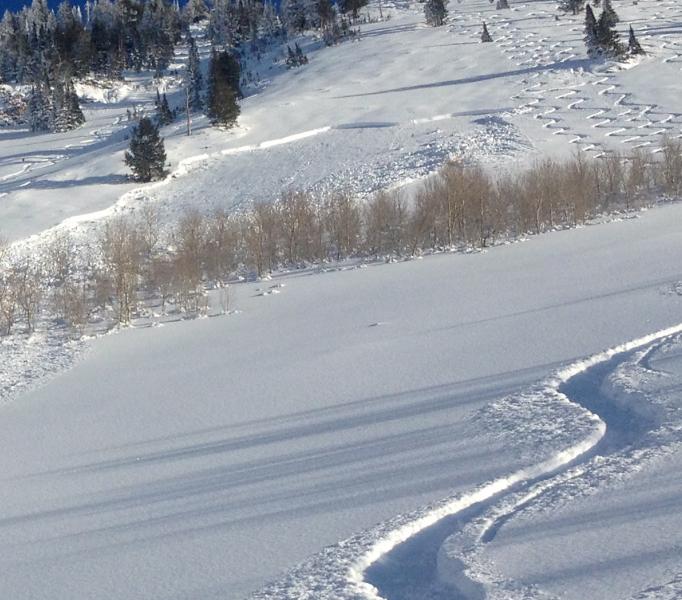
At first glance, one might think that this last winter blended in with many others; but the truth is each winter is defined as ‘unusual’, punctuated by real events with real people affected by close calls and, unfortunately, tragedy. If you look at the pure numbers, we suffered our “average” number of fatalities across the state – 4 – but in terms of the mark it left upon communities and families, particularly our avalanche family, it sits among that loose plurality of “second to none”. By this I mean we, the Utah avalanche community, lost one of our own – Craig Patterson – a Utah Department of Transportation Avalanche Team member from Little Cottonwood Canyon. On the afternoon of April 11, Craig was killed by an avalanche he presumably triggered high on Kessler Peak, a prominent and jagged mountain that is nearly wall-to-wall with avalanche paths, including avalanche paths that threaten Big Cottonwood Canyon. I say “presumed” because he was traveling alone that afternoon. He was carried nearly 1300’ over a couple cliff bands and was killed by trauma. Eight avalanche professionals from the Utah Avalanche Center and the Utah Department of Transportation went in the next day to conduct the investigation. To say that this was part of a cathartic or healing process would be missing the point. We all travel in the mountains alone and all agreed that this could have happened to anyone of us. The investigation was the easy part. The hard part fell to those going in the night before to retrieve Craig at the base of the Kessler Slabs. Hardest of all of course was going to see his wife and 6-year-old daughter.
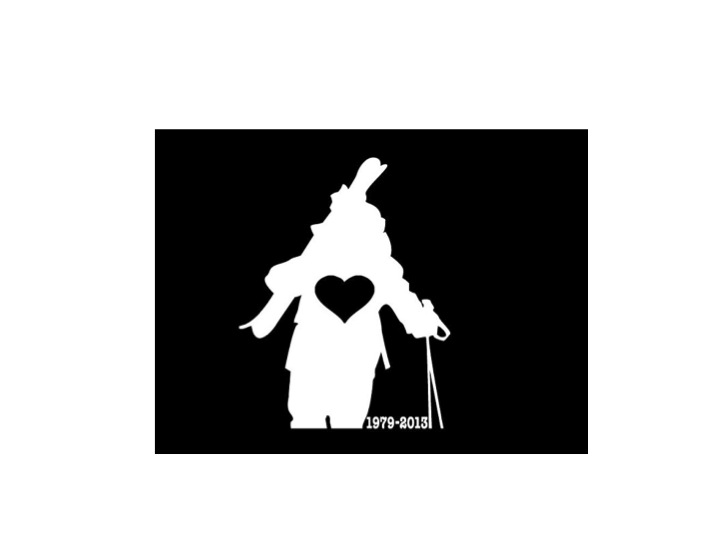
But each person killed in an avalanche has his or her own family and community and their passing triggers waves of denial, shock, sadness, even anger. On January 18, a family snowmobiling in the Uintas stopped for lunch just off the groomed road of Mill Hollow in the west fork of the upper Duchesne River drainage. What follows may be more than a family can bear. Four young family members walk to the edge of what appears to be a packed trail to overlook the upper Duchesne. The “edge” happens to be a cornice, which immediately collapses, sending two boys Traven and Coleman Sweat (aged 7 and 14) over the edge, triggering another avalanche below. Each was fully buried and died from asphyxiation. This twin fatality stops us in our tracks. Many times people like to say, “They were risk takers”, “They were doing what they loved”, “They shouldn’t have been out there”…but this one leaves one speechless with sorrow. This family, too, will never be the same.
A 4th fatality was a Pleasant Grove, Utah local snowmobiling down along the southern end of the Manti-Skyline Plateau. James Childs, 32, was riding with a number of others when they all became separated, side-hilling and high-marking the numerous slopes east of 12-mile Canyon, just north of Interstate 70. When the riders regrouped, they noticed that one of their party was missing. He was later found buried 4’ deep from a 2’ deep and 350’ wide avalanche below a steep northeast facing slope at 10,400’. He is survived by his wife and four children.
There are tragedies and there are reasons to rejoice.
This winter marked a time where we investigated three full and complete avalanche burials with three full and complete recoveries. This is a testament to teams being equipped and practiced with rescue gear and luck, as nearly every involvement one could argue the presence or absence of it. Famously, Shakespeare’s plays were categorized as either comedy or tragedy. To wit – On Friday January 11th, a party of ski patrollers and avalanche educators on their day off decided to test the snow stability in the well-named Depth Hoar Bowl of Alexander Basin of upper Mill Creek. The terrain sits between Gobbler’s Knob to the west and Wilson Peak to the east. The 2nd skier down the slope unintentionally triggered an 18” deep and 50’ wide avalanche that washed around him but didn’t carry or sweep him off his feet. The following day, another experienced party skied the remaining portion of the bowl, only this time it was the 3rd skier on the slope that triggered the slide and he was subsequently buried with the top of his helmet sticking out of the snow. With some amusement (that everyone was ok and now there was little danger left in that particular terrain), the next day’s forecaster highlighted the events and asked, “Ok, any more takers for Depth Hoar Bowl?”
Another very close call in early February involved a completely buried snowmobiler in the Whisky Hill area near Monte Cristo of the Ogden area mountains. A very experienced snowmobiler unintentionally triggered a hard slab avalanche while very low on the avalanche path, but couldn't escape the 4' deep and 400' wide slide. The rest of the group quickly located him with beacons, pinpointed him with a probe and several people quickly dug him out. It was a textbook rescue, executed flawlessly. They uncovered the victim in about 5 minutes. Luckily, this group regularly practices rescue scenarios and the practice paid off. (Bruce Tremper photo below)
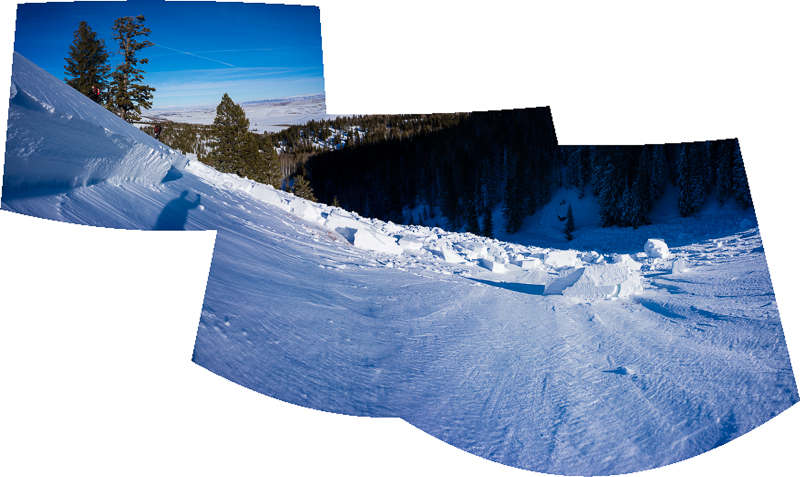
Another accident involved a couple of backcountry skiers in Broads Fork of Big Cottonwood Canyon. An experienced party of four were heading back up for their third lap when a natural full-depth glide avalanche released above, engulfing two and injuring one. What is significant is that these glide avalanches are fairly rare...and rarer still that they lead to avalanche accidents. Poorly understood, these glide avalanches tend to release on steep smooth surfaces such as rock slabs or grassy slopes and have been known to release in late fall, mid-winter, and spring. Of note, Utah had two fatalities in the spring of 2001 in Stairs Gulch, one drainage to the west. (Tremper photo below - note the full depth release on the rocky terrain to the left of the ski tracks).
A couple weather events that caught our eye included
· Four rain events in the last day of November through the first week of December (a portent of things to come?)
· The “upside down storm of January 10-12 that put a foot of snow in the mountains and up to 20-44” in the valleys and mid-elevations…followed by…
· As Professor Jim Steenburgh of the University of Utah Meteorology Dept. put it (on his blog www.wasatchweatherweenies.com) “The Mother of All Inversions” – A bullet-proof ridge of high pressure parked itself over Utah, sending temps down to -46F (near Logan) and -21F (Solitude). Not coincidentally, declining air quality in the valley made national news, comparing our choking smog with areas of China…
(UACObserver Andy Rich, below, eyes an avalanche triggered from the day before in the backcountry along the Park City ridgeline)
The UAC kept the same staff. Toby and Paige Weed ran the Logan branch; Craig Gordon the Western Uintas; UAC Director Bruce Tremper, Evelyn Lees, Brett Kobernik and Drew Hardesty held down the Wasatch; Kobernik and Gordon shared the Manti-Skyline Plateau. Max Forgensi ably manages the office for the La Sals and Abajos in southeastern Utah. Paul Diegel continues to steer the powerhouse non-profit side of the Utah Avalanche Center. Devin Dwyer was our ace coordinating most of our educational pursuits while Trent Meisenheimerwas invaluable in assisting with education, field days, video editing, and updating much of our education and curriculum. Over 650 avalanche pros and enthusiasts attended this fall’s Utah Snow and Avalanche Workshop; mc’d by a sleek-and-tanned Craig Gordon in his best formal Hawaiian attire – tuxedo and bow-tie above the belt, shorts and flip-flops below. His patented Know Before You Go program has now reached over 165,000 youth since its inception in ’04. Drew Hardesty was the keynote speaker for the annual Skinny Skis Avalanche Awareness night in Jackson and gave a standing-room-only crowd of 700 musings on The Past, Present, and Future of the Backcountry – Freedom and Responsibility for the Individual and Community. (Photo below of mc Craig Gordon and the crowd at the Utah Snow and Avalanche Workshop)

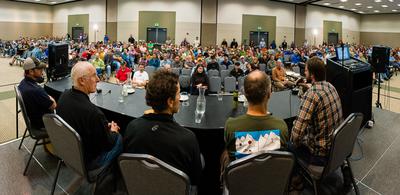
Other news from the year –
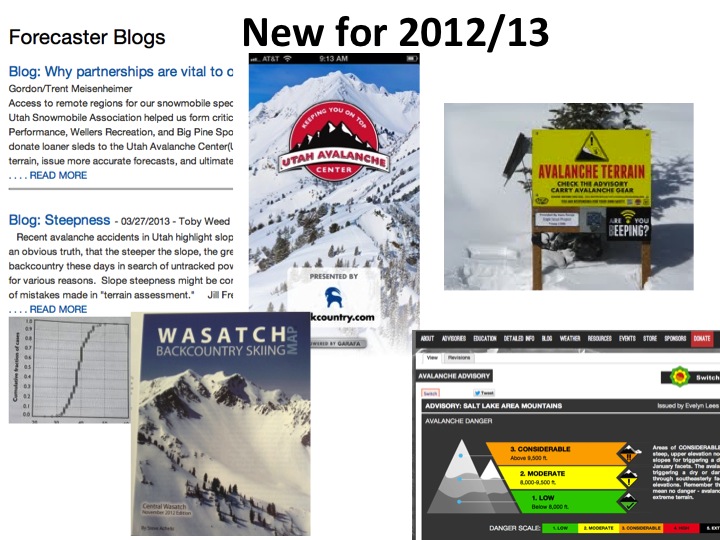
· With the help of Garafa, LLC and sponsored by a generous grant from Backcountry.com, the UAC developed the 1st of its kind iPhone app and went live this spring. It allows users to get all the latest info as well as take photos and submit obs to the UAC.
· Steve Achelis, long time board member, Search and Rescue IC, ski patroller, author, and philanthropist, created and developed an exhaustive on-line place-names map on Google Earth to aid in communication and search and rescue missions. (wbskiing.com). Water and tear-resistant maps were also tough to keep in stock, with all proceeds supporting the Utah Avalanche Center
· OR (Outdoor Research) and KLIM both contributed generous winter gear keeping the staff comfortable and professional during field days.
· New avalanche-informational signs with beacon checkers were installed at many trailheads.
· We continued developing a new website utilizing “basic” and “advanced” page to customize the needs of our users…and will continue refining this for the 13/14 season.
· A Forecaster’s Blog was a giant success with over 30 topics submitted, ranging from Early Season Faceting, to the Effectiveness of Airbags, to Slope Steepness, to Danger in the Danger Ratings as well as a Case Study the Effects of Solar Radiation and Temperature on the March 4th 2012 Avalanche Cycle
We have a long list of people to thank:
You. Thank you for your support – whether it is financial, snow and avalanche related, or just being an active member of the avalanche community on the Greatest Snow on Earth. Your involvement and support is 2nd to none.
- Thanks to all of you who have sent observations this season. Crowdsourcing is the most valuable information we get. Other avalanche centers all over the world are modeling our program. And special thanks to all the Utah avalanche professionals at our world class mountain resorts, Utah Department of Transportation and Wasatch Powderbird Guides.
- Thanks to the Larry Dunn and the National Weather Service who provide office space, weather forecasting, tech support and great company.
- The Utah Avalanche Center is a partnership between the Forest Service and the non-profit, Friends of the Utah Avalanche Center. On the Forest Service side, thanks to unwavering support from my boss Larry Lucas and the Uinta-Wasatch-Cache National Forest and the financial support from Liz Close of the Forest Service Intermountain Region. On the non-profit side, most of the funding for the partnership comes from private sources through the Friends of UAC, which operates like a well-oiled machine thanks to the wise leadership and very hard work of its Executive Director, Paul Diegel along with employees, Devin Dwyer and Trent Meisenheimer and its powerhouse Board of Directors, Rich Mrazik, Steve Achelis, Roger Kehr, TJ Kolanko, Jenn Berg, Reid Persing, Dan Gardiner, Curt Kennedy, Mike Dawes, Laura Briefer, Marion Bonar and Kristine Taylor. It's an honor to work with such an amazing board.
- Direct funding comes from longtime partners, Utah Division of State Park and Recreation, Utah Division of Emergency Management, Salt Lake County and a grant from the Wyoming Recreation Trails Program.
- Sponsors who donate to the Friends of Utah Avalanche Center are too numerous to list here but you can find them on our Sponsors Page.
- And special thanks to all of you who donate directly to the FUAC and attend the gargantuan fall fundraiser generously provided by our longtime supporter, Black Diamond.
Drew Hardesty
Forecaster, Utah Avalanche Center


